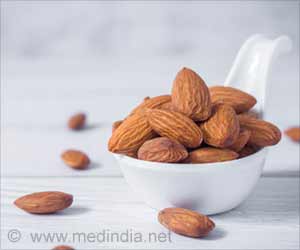Eating about 57g of almonds post exercise can increase the level of healthy fats in the body and aid recovery.
- Almonds provide a unique and complex nutrient and polyphenol mixture that may support metabolic recovery from stressful levels of exercise
- Adding 57 g of almonds to the diet every day for a month increases levels of the beneficial fat, 12,13-DiHOME in blood samples immediately after a session of intense exercise //
- Daily consumption of almonds leads to a change in metabolism, downregulating inflammation and oxidative stress from exercise and enabling the body to recover faster
Almond intake alters the acute plasma dihydroxy-octadecenoic acid (DiHOME) response to eccentric exercise
Go to source). “Here we show that volunteers who consumed 57g of almonds daily for one month before a single ‘weekend warrior’ exercise bout had more beneficial 12,13-DiHOME in their blood immediately after exercising than control volunteers. They also reported feeling less fatigue and tension, better leg-back strength, and decreased muscle damage after exercise than control volunteers,” said corresponding author Dr. David C Nieman, a professor and director of the Appalachian State University Human Performance Laboratory at the North Carolina Research Campus, US.
One Month Dietary Supplementation with Almonds
The clinical study involved 38 men and 26 women between the ages of 30 and 65 who did not regularly exercise with weights. Half were assigned to the almond diet group, while the other half were assigned to the control group, which ate a calorie-matched cereal bar every day. The researchers took blood and urine samples before and after the four-week period of dietary supplementation. Performance measures included a 30 second Wingate anaerobic test, a 50meter shuttle run test, and vertical jump, bench press, and leg-back strength exercises. Additional blood and urine samples were taken immediately after this 90minute session of ‘eccentric exercise’ and daily for four days afterwards.After each blood draw, the participants filled out the ‘Profile of Mood States’ (POMS) questionnaire to quantify their mental state, and rated their delayed onset muscle soreness – that is, pain and stiffness felt after unaccustomed or strenuous exercise – on a 10-interval scale.
As expected, the 90minute exercise led to an increase in the volunteers’ self-reported feeling of muscle damage and muscle soreness, as well as an increased POMS score, indicating self-reported decreased vigor and increased fatigue, anxiety, and depression.
The exercise also resulted in transient elevated levels of pro-inflammatory cytokines such as IL-6, IL-8, IL-10, and MCP-1 in the blood, consistent with minor muscle damage. However, these changes in cytokines were equal in the almond and cereal bar groups.
Differences in Two DiHOME Concentrations
Importantly, the concentration of the beneficial 12,13-DiHOME in blood plasma of almond group participants was 69% greater than in control group participants immediately after exercise. 12,13-DiHOME has been shown to improve fatty acid transport and uptake by skeletal muscle, hence boosting metabolic recovery after exercise.The reverse was found for another oxylipin, the mildly toxic 9,10-Dihydroxy-12-octadecenoic acid (9,10-diHOME). This was 40% higher immediately after exercise in the blood of the control group than in the almond group. Unlike 12,13-DiHOME, 9,10-diHOME has been shown have negative effects on overall health and the body’s recovery to exercise.
Polyphenols Present in Almond Skin may be Key
Daily consumption of almonds leads to a change in metabolism, downregulating inflammation and oxidative stress from exercise and enabling the body to recover faster.Researchers conclude that almonds provide a unique and complex nutrient and polyphenol mixture that may support metabolic recovery from stressful levels of exercise. Almonds have high amounts of protein, healthy types of fats, vitamin E, minerals, and fiber. And the brown skin of almonds contains polyphenols that end up in the large intestine and help control inflammation and oxidative stress.
Reference:
- Almond intake alters the acute plasma dihydroxy-octadecenoic acid (DiHOME) response to eccentric exercise - (https://www.frontiersin.org/articles/10.3389/fnut.2022.1042719/full)
Source-Medindia
















